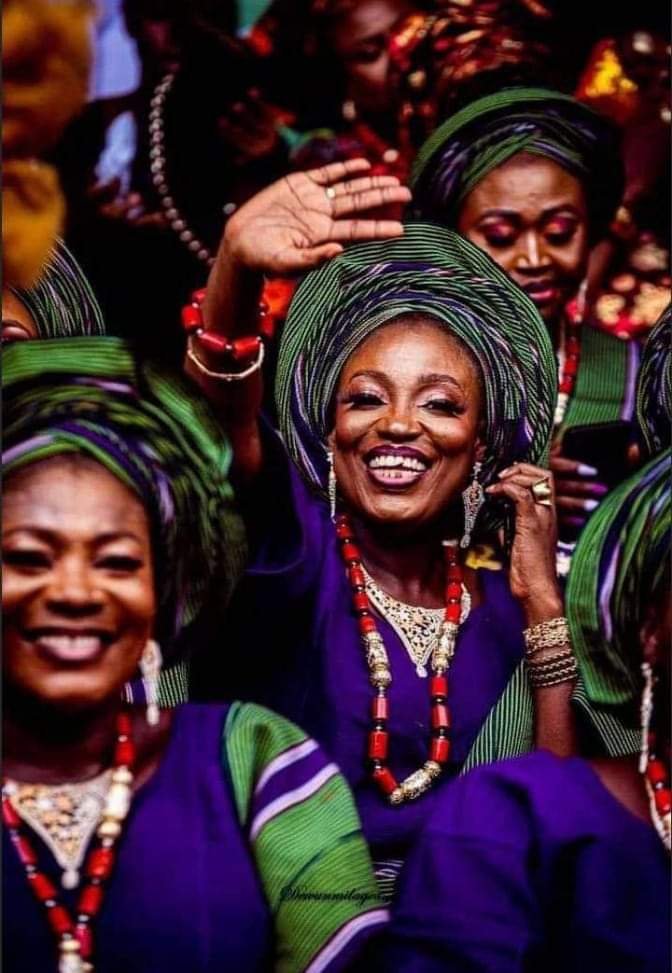In recent years, Aso-Oke has experienced a renaissance, blending traditional techniques with contemporary aesthetics. Designers and weavers have pushed the boundaries, introducing fresh patterns, unconventional color combinations, and innovative textures. This fusion of tradition and modernity has resulted in a vibrant tapestry of possibilities, captivating the hearts of fashion enthusiasts and collectors worldwide. One notable aspect of modern Aso-Oke designs is the incorporation of bold patterns. While traditional motifs still hold their significance, contemporary patterns offer a unique twist. Geometric shapes, abstract designs, and even pictorial representations are now intricately woven into the fabric, adding an exciting element to this age-old art form. These bold patterns make a statement, allowing wearers to showcase their individuality and stand out in a crowd.



Also, modern Aso-Oke embraces a diverse range of color combinations. While the traditional color palette remains beloved, contemporary interpretations introduce a refreshing spectrum of hues. From vibrant and electric tones to soft pastels and earthy neutrals, the color choices are endless. This broad range of options allows individuals to select Aso-Oke that resonates with their personal style, occasion, or cultural context. Asides the patterns and colors, innovative textures have made their way into the world of Aso-Oke. Weavers experiment with different weaving techniques, yarns, and embellishments to create a rich tactile experience. Textured Aso-Oke may feature raised surfaces, intricate embroidery, or the incorporation of other materials like beads or sequins. These textured elements add depth and dimension to the fabric, further enhancing its visual appeal.
Another exciting development is the ability to customize Aso-Oke according to personal preferences. Whether it’s for a wedding, a special event, or everyday wear, individuals can collaborate with skilled weavers to bring their unique vision to life. From selecting specific patterns, colors, and even the type of fabric, customization allows individuals to create Aso-Oke pieces that truly reflect their personality and style. This level of personalization has reinvigorated interest in Aso-Oke and made it a sought-after choice for fashion-forward individuals.
The evolution of Aso-Oke into a contemporary work of art has not only expanded its appeal within Nigeria but also gained international recognition. Aso-Oke has graced runways, featured in fashion editorials, and even been embraced by global celebrities. Designers and fashion enthusiasts from around the world are drawn to its cultural significance, meticulous craftsmanship, and the opportunity it provides to make a bold fashion statement. Beyond its aesthetic appeal, modern Aso-Oke continues to carry the weight of tradition and heritage. Each piece tells a story, reflecting the customs, beliefs, and history of the Yoruba people. It serves as a bridge between the past and the present, celebrating the legacy of the Yoruba culture while embracing contemporary influences.



So, whether you prefer a classic design that pays homage to tradition or crave a vibrant, cutting-edge creation, the modern world of Aso-Oke has something to offer. It celebrates the fusion of artistry, craftsmanship, and personal expression, allowing individuals to adorn themselves in a fabric that encapsulates the rich tapestry of their unique identity.
Modern Aso-Oke has breathed new life into this ancient art form, offering a myriad of possibilities for self-expression and fashion exploration. The infusion of bold patterns, diverse color combinations, textured surfaces, and customizable options has propelled Aso-Oke into the realm of wearable art. As it continues to captivate the imagination of designers, collectors, and fashion enthusiasts worldwide, Aso-Oke stands as a testament to the enduring beauty and cultural significance of the Yoruba people.
Originating from the Yoruba people, Aso-Oke has its roots embedded in the soil of Nigeria. It’s a textile tradition that has thrived for centuries, passed down through generations, and celebrated as an essential part of Yoruba heritage. Various towns and cities in Yorubaland, such as Iseyin, Oyo, and Ibadan, have become renowned centers for Aso-Oke production, nurturing skilled weavers who transform threads into masterpieces. For the Yoruba women, Aso-Oke holds a special place in their hearts. Beyond its cultural significance, it provides them with a means of self-expression and economic empowerment. By engaging in the production of Aso-Oke, they not only meet their domestic needs but also impart their weaving expertise to the younger generation, ensuring the preservation of this remarkable craft.
Now, let’s unravel the layers of Aso-Oke. Traditionally, it comprises multiple layers, each meticulously woven to create a fabric of substance and grandeur. These layers contribute to its weight and thickness, enhancing its regal appearance. However, to cater to contemporary fashion tastes and make it more accessible for casual wear, new techniques and production methods have emerged, offering lighter and more versatile versions of Aso-Oke. These fascinating layers contribute to its distinctive appeal. The base layer, known as the “prestige layer,” forms the foundation of Aso-Oke. It is typically made from a sturdy cotton or silk material, providing strength and structure to the fabric. The prestige layer serves as the canvas upon which the intricate patterns and designs are woven.
Above the prestige layer lies the “pattern layer,” which showcases the true artistry of Aso-Oke. Skilled weavers employ various techniques, such as supplemental weft weaving and hand-dyeing, to create captivating patterns, motifs, and color combinations. These designs can range from geometric shapes and stripes to intricate floral motifs and symbolic representations. The pattern layer is where the true beauty and intricacy of Aso-Oke come to life.
To further enhance the visual appeal and richness of the fabric, an additional layer called the “embellishment layer” may be incorporated. This layer involves the addition of supplementary threads, such as metallic or contrasting-colored threads, to create decorative accents, borders, or intricate detailing. These embellishments add a touch of glamour and elevate the regal essence of Aso-Oke.
Now, as contemporary fashion tastes evolve, new techniques and production methods have emerged to offer lighter and more versatile versions of Aso-Oke. While the traditional layered approach remains, advancements in weaving technology and design innovation have led to the creation of lighter-weight Aso-Oke fabrics that are suitable for modern, everyday wear. Weavers now experiment with blending different fibers, such as cotton, silk, and synthetic materials, to achieve a balance between comfort and elegance. The introduction of lighter threads and a reduction in the number of layers contribute to a more breathable and flexible fabric, allowing individuals to wear Aso-Oke comfortably in various settings, be it formal occasions or casual outings.
In addition to the evolution of the fabric itself, contemporary Aso-Oke designs also showcase a fusion of traditional and modern elements. Weavers incorporate contemporary patterns, unconventional color combinations, and even incorporate embellishments such as sequins or beads to cater to changing fashion preferences while maintaining the essence of Aso-Oke’s cultural heritage.
These advancements in production techniques and design innovation have made Aso-Oke more accessible to a wider audience, both within Nigeria and globally. It has expanded the versatility of the fabric, allowing individuals to incorporate Aso-Oke into their daily fashion choices, not just limited to special occasions. So, whether you choose to adorn yourself in the magnificent layers of traditional Aso-Oke or opt for the contemporary adaptations, you can embrace the allure and elegance of this cherished Yoruba textile, carrying its legacy forward with grace and style.
One question that often arises is, “How much does the prestigious Aso-Oke cost?” Well, it varies depending on factors such as the intricacy of the design, the type of fabric, and the expertise of the weaver. Aso-Oke can range from affordable options for everyday wear to exquisite, high-end pieces that command a higher price tag. Nevertheless, its value transcends monetary worth, as it embodies a cherished cultural heritage and an artistic legacy.
As you witness the joyous celebrations and vibrant gatherings in Nigeria, you’ll notice the allure of Aso-Oke weaving through the crowd. It binds families and friends together through the concept of “Aso-ebi,” where individuals don matching Aso-Oke ensembles to symbolize unity and solidarity. The fabric fosters a sense of belonging and amplifies the visual spectacle of Yoruba “Owambes,” transforming any occasion into a feast for the eyes.


Aso-Oke stands tall as a living testament to the skill, creativity, and cultural heritage of the Yoruba people. It represents more than just threads intricately woven together; it encapsulates the essence of tradition, celebration, and individuality. From its roots in Yorubaland to its global recognition, this remarkable fabric continues to captivate hearts, unite communities, and adorn the world with its mesmerizing beauty. So, let us celebrate Aso-Oke and the vibrant spirit it brings to life’s grand tapestry!
.
Joseph Omoniyi
https://twitter.com/Ola_josef?t=mFqIqPFZ07cIvBVM8-88lw&s=09




